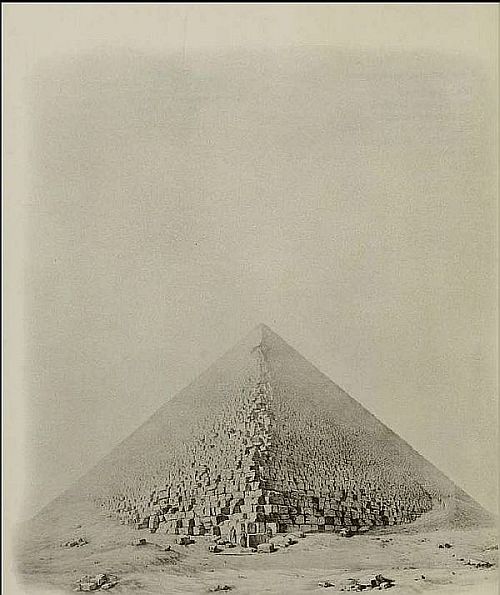Peter Tompkins - Secrets of the Great Pyramid-Harper Row (1971)
Here you can read online Peter Tompkins - Secrets of the Great Pyramid-Harper Row (1971) full text of the book (entire story) in english for free. Download pdf and epub, get meaning, cover and reviews about this ebook. genre: Detective and thriller. Description of the work, (preface) as well as reviews are available. Best literature library LitArk.com created for fans of good reading and offers a wide selection of genres:
Romance novel
Science fiction
Adventure
Detective
Science
History
Home and family
Prose
Art
Politics
Computer
Non-fiction
Religion
Business
Children
Humor
Choose a favorite category and find really read worthwhile books. Enjoy immersion in the world of imagination, feel the emotions of the characters or learn something new for yourself, make an fascinating discovery.

- Book:Secrets of the Great Pyramid-Harper Row (1971)
- Author:
- Genre:
- Rating:3 / 5
- Favourites:Add to favourites
- Your mark:
- 60
- 1
- 2
- 3
- 4
- 5
Secrets of the Great Pyramid-Harper Row (1971): summary, description and annotation
We offer to read an annotation, description, summary or preface (depends on what the author of the book "Secrets of the Great Pyramid-Harper Row (1971)" wrote himself). If you haven't found the necessary information about the book — write in the comments, we will try to find it.
Peter Tompkins: author's other books
Who wrote Secrets of the Great Pyramid-Harper Row (1971)? Find out the surname, the name of the author of the book and a list of all author's works by series.
Secrets of the Great Pyramid-Harper Row (1971) — read online for free the complete book (whole text) full work
Below is the text of the book, divided by pages. System saving the place of the last page read, allows you to conveniently read the book "Secrets of the Great Pyramid-Harper Row (1971)" online for free, without having to search again every time where you left off. Put a bookmark, and you can go to the page where you finished reading at any time.
Font size:
Interval:
Bookmark:



Does the Great Pyramid of Cheops enshrine a lost science? Was this last remaining of the Seven Wonders of the World, often descried as the most sublime landmark in history, designed by mysterious architects who had a deeper knowledge of the secrets of this universe than those who followed them?
For centuries a debate has been waged between supporters of such a theory and its opponents, with eminent scientists and academicians lining up on either side. Though all agree that the Great Pyramid is at least four thousand years old, none can say for certain just when it was built, by whom, or why.
Till recently there was no proof that the inhabitants of Egypt of five thousand years ago were capable of the precise astronomical calculations and mathematical solutions required to locate, orient and build the pyramid where it stands.
It was attributed to chance that the foundations were almost perfectly oriented to true north, that its structure incorporated a value for (the constant by which the diameter of a circle may be multiplied to give its true circumference) accurate to several decimals and in several distinct and unmistakable ways; that its main chamber incorporated the "sacred" 3-4-5 and 25-3 triangles (a2 + b2 = c2) which were to make Pythagoras famous and which Plato in his Timaeus claimed as the building blocks of the cosmos. Chance was said to be responsible for the fact that the Pyramids angles and slopes display an advanced understanding of trigonometric values, that its shape quite precisely incorporates the fundamental proportions of the "Golden Section," known today by the Greek letter (pronounced phi), revered equally by masters of the cinquecento and luminaries of modern architecture.
According to modern academicians the first rough use of in Egypt was not till about 1700 B.C. at least a millennium after the Pyramid; Pythagoras' theorem is attributed to the fifth century B.C.; and the development of trigonometry to Hipparchus in the second century before Christ. That's what the Egyptologists say, and that is what they put in their textbooks.
Now the whole subject has had to be reviewed.
Recent studies of ancient Egyptian hieroglyphs and the cuneiform mathematical tablets of the Babylonians and Sumerians have established that an advanced science did flourish in the Middle East at least three thousand years before Christ, and that Pythagoras, Eratosthenes, Hipparchus and other Greeks reputed to have originated mathematics on this planet merely picked up fragments of an ancient science evolved by remote and unknown predecessors.
The Great Pyramid, like most of the great temples of antiquity, was designed on the basis of a hermetic geometry known only to a restricted group of initiates, mere traces of which percolated to the Classical and Alexandrian Greeks.
These and other recent discoveries have made it possible to reanalyze the entire history of the Great Pyramid with a whole new set or references: the results are explosive. The common and indeed authoritative assumption that the Pyramid was just another tomb built to memorialize some vainglorious Pharaoh is proved to be false.
For a thousand years men from many occupations and many stations have labored to establish the true purpose of the Pyramid. Each in his own way has discovered some facet, each in its own way valid. Like Stonehenge and other megalithic calendars, the Pyramid has been shown to be an almanac by means of which the length of the year including its awkward .2422 fraction of a day could be measured as accurate as with a modern telescope. It has been shown to be a theodolite, or an instrument for the surveyor, of great precision and simplicity, virtually indestructible. It is still a compass so finely oriented that modern compasses are adjusted to it, not vice versa.
It has also been established that the Great Pyramid is a carefully located geodetic marker, or fixed landmark, on which the geography of the ancient world was brilliantly constructed; that it served as a celestial observatory from which maps and tables of the stellar hemisphere could be accurately drawn; and that it incorporates in its sides and angles the means for creating a highly sophisticated map projection of the northern hemisphere. It is, in fact, a scale model of the hemisphere, correctly incorporating the geographical degrees of latitude and longitude.
The Pyramid may well be the repository of an ancient and possibly universal system of weights and measures, the model for the most sensible system of linear and temporal measurements available an earth, based on the polar axis of rotation, a system first postulated in modern times a century ago by the British astronomer Sir John Herschel, whose accuracy is now confirmed by the mensuration of orbiting satellites.
Whoever built the Great Pyramid, it is now quite clear, knew the precise circumference of the planet, and the length of the year to several decimals data which were not rediscovered till the seventeenth century. Its architects may well have known the mean length of the earth's orbit round the sun, the specific density of the planet, the 26,000-year cycle of the equinoxes, the acceleration of gravity and the speed of light.
But to disentangle the authentic from the phony in what has been attributed to the builders of the Great Pyramid has required the technique of a Sherlock Holmes. To climax the story there is a mystery of detection to match the classic style of Sax Rohmer's Abu Hassan, complete with radiography by cosmic rays.
Ten miles west of the modern city of Cairo at the end of an Acacia, tamarind and eucalyptus avenue stands a rocky plateau. A mile square, it dominates the luxuriant palm groves of the Nile Valley from a height of 130 feet. On this man-leveled plateau, called Giza by the Arabs, stands the Great Pyramid of Cheops. To the west stretch the vast wastes of the Libyan desert.
The Pyramids base covers 13 acres, or 7 midtown blocks of the city New York. From this broad area, leveled to within a fraction of an inch, more than two-and-a-half million blocks of limestone and granite weighing from 2 to 70 tons apiece rise in 201 stepped tiers to the height of a modern forty-story building, etched against the cloudless blue of the Egyptian skies.
In terms of solid masonry, the structure contains more stone than all the cathedrals, churches and chapels built in England since the time of Christ; as a feat in masonry it was not to be matched till the construction of Bounder Dam. Modern engineers are astounded by both the enormity of the problems involved in the constriction of the Pyramid and the opticians precision with which these problems were resolved. As originally designed, with its full mantle of polished limestone, the Pyramid must have been a dazzling sight. Unlike marble, which tends to become eroded with time and the weather, limestone becomes harder and more polished.
Near the Pyramid of Cheops stands two more pyramids, one, slightly smaller, attributed to Cheops' successor, Kephren, and another, smaller still, partly sheathed in red granite, attributed to Kephren's successor Mykerinos. Together with six diminutive pyramids, supposedly built for Cheops' wives and daughters, they form what is known as the Giza complex. About a hundred more pyramidal structures of various sizes and in various stages of dilapidation follow the western bank of the Nile southward toward the Sudan, mostly within one degree of latitude, or 70 miles, but it is the Great Pyramid, unique in size and proportion, which is of paramount interest in this story.
Next pageFont size:
Interval:
Bookmark:
Similar books «Secrets of the Great Pyramid-Harper Row (1971)»
Look at similar books to Secrets of the Great Pyramid-Harper Row (1971). We have selected literature similar in name and meaning in the hope of providing readers with more options to find new, interesting, not yet read works.
Discussion, reviews of the book Secrets of the Great Pyramid-Harper Row (1971) and just readers' own opinions. Leave your comments, write what you think about the work, its meaning or the main characters. Specify what exactly you liked and what you didn't like, and why you think so.






